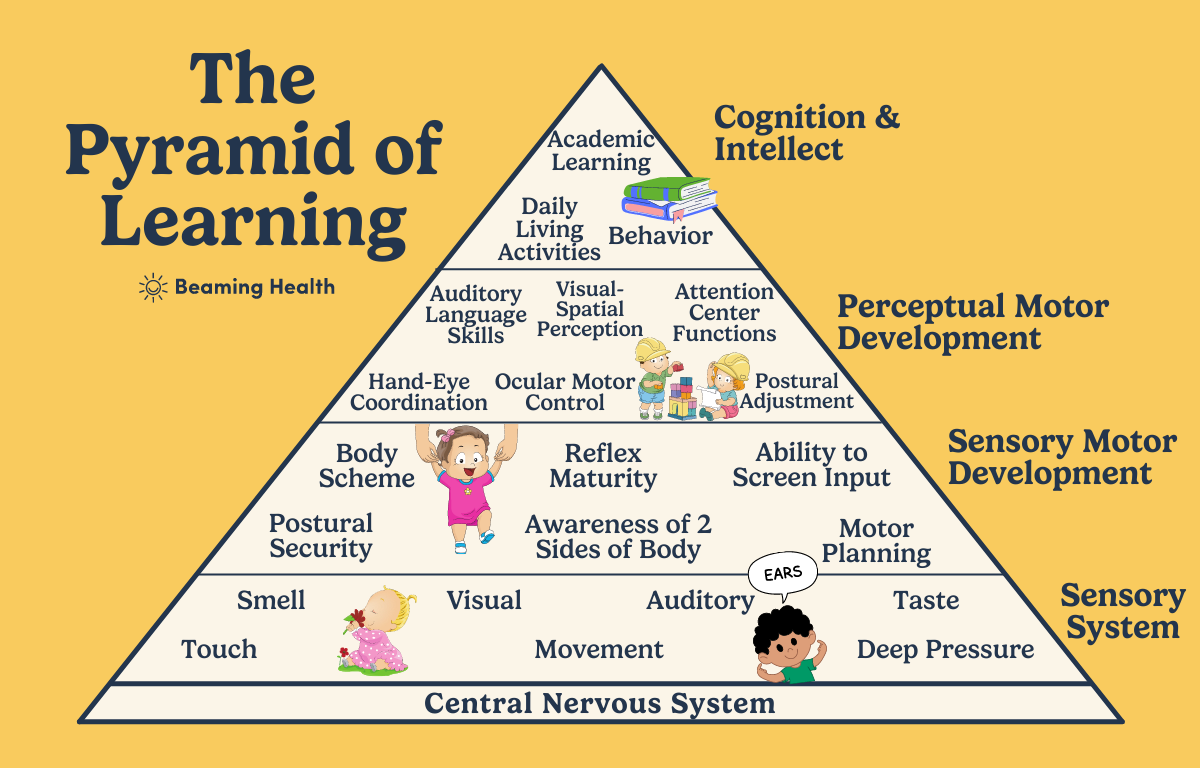The importance of hierarchical progressions
Updated: January 11, 2024 · 10 Minute Read

Reviewed by:
Melanie Hsu, Ph.D.
Highlights
- Hierarchical progression is the idea that areas of development build upon each other as a child moves through development.
- The Pyramid of Learning is a visual representation of hierarchical progressions. The pyramid starts with the central nervous system at the bottom and ends with cognition and intellect at the very top.
- Play is important to a child’s development for many reasons. Play teaches children to understand how others think and that different people have different thoughts, feelings, and experiences than their own.
Beaming Health’s co-founder Marissa Pittard sat down with autism expert Melanie Hsu, Ph.D. to talk about the science behind autism and the therapies that can help children thrive. They answered the most common questions about autism and chatted live with parents. In this clip, Melanie explains what hierarchical progressions are and why it is so important in understanding autistic individuals.
This transcript has been edited for length and clarity. You can find the full video conversation in the Beaming community.
What are hierarchical progressions?
A concept that’s going to become important in how we talk about autism and development is the concept of hierarchical progressions. Early areas of development build upon each other to help children learn skills and develop into adults. If you understand how behaviors and how development builds upon each other, you can see where potential breakdowns are.
What’s an example of hierarchical progression?
.png)
An example we, especially us child psychologists, really like to use, is play.
- Play begins with sensory exploration, using your senses to make sense of your world. That’s where you start. And that’s why a lot of times babies, for example, everything goes in their mouth or they're looking at things really carefully. Or they're touching and feeling. They're using their senses to make sense of their world.
- Once a child understands how the world is and how to interact with it, they start to learn functional play. This is kind of that pre-academic play where you start to recognize attributes. Things like colors, categorization, putting puzzles together, and understanding that level above just understanding what something is.
- Play then progresses to symbolic play, where something can take the place of another. So for example, your spoon isn’t just a spoon, it's also a plane. And so as you can see that’s one more step beyond just understanding the physical attributes, figuring out how it works in conjunction with something, but also than viewing it with life.
- Last is social play where children begin to play pretend. Children learn the ability to role play, for example, and to take on the thoughts and feelings of others.
Why do psychologists talk about play so much?
One of the reasons why psychologists go on and on about play so much is this is actually the way children learn theory of mind. Theory of mind is that understanding of how others think and that they have different thoughts, feelings, and experiences than you. When you see your parent or another adult doing something, you take on that persona and you try it on, just like you try on a costume. And you’re seeing things through their eyes and you're understanding how all those things fit together. That’s where that social piece comes from.
But as you can see sometimes an individual can get stuck in one of those stages and doesn’t move on to get to the top of where this should be leading.
How do children learn to communicate well?
Communication starts with communicative intent, understanding that you can have an effect on someone else. And then the motor planning, to be able to make certain sounds. And then the memory that certain sounds mean certain things because language is very abstract. And then once you put all those things together, knowing the social context that communication is for.
As we know, communication doesn’t always work. In every single situation, you have to switch your behaviors. So you can see how that social piece gets woven into every single part of development. You can see those breakdowns sometimes may be getting in a person's way of being able to put all these things together.
Understanding hierarchical progressions can help you also understand behavior
Understanding all these things also helps us understand where a behavior is coming from. Why does an individual engage in certain things? Because nothing happens in a vacuum and understanding these from a basic park helps us be able to put those together again to say, ‘What is causing a problem or a block for this individual?’
The Pyramid of Learning
The Pyramid of Learning is probably the most complex part of children’s development to understand.

What we really like about the Pyramid of Learning, which came all the way back from 1991, is an understanding of how we use hierarchical progressions to continue to move forward in development.
On the bottom of this pyramid is the central nervous system and then on the top of it is academic learning or the intellectual cognitive part of how everything comes together.
When a medical team talks about neuropsychological underpinnings, we are talking about development in general. With autism spectrum disorder, because it is a neurodevelopmental disorder, there are many things neuropsychologically and neurologically that get thrown off that often will lead to more problems.
And just like with building a house, if you don’t have a strong foundation, you can see that there are going to be more difficulties the higher up you go.
Level 1: Sensory system
Our central nervous system lies below our sensory systems. Our sensory system is the way that we take in information from our environment and make sense of it. How we can interact with the world accurately, as well as efficiently.
Sensory processing is also the basis of regulation. Being able to be in a state of being efficient, for example, and not being either overstimulated or having too many things going on or under-stimulated where you need to do things to wake yourself up.
Many of us take these things for granted because our nervous system works the way that it's supposed to and we don't have to worry about filtering things out or getting more sensory information in.
From a sensory perspective, this is one of the reasons why it's one of the symptoms of autism spectrum disorders. It's often one of the first things a parent notices. A child moves more than they should or they get overwhelmed more than they should, such as with sounds or with touch. Or they are constantly moving and seeking those things out.
When your nervous system isn't working the way that it's supposed to, your body isn't as efficient, so you use more energy for the things that should come naturally.
And this is again just that bottom part. We haven’t even kind of got into the other parts that get into it.
Level 2: Sensory-motor development
Sensory-motor development is that next part that lies on top of sensory processing. Again, being able to put things together. Being able to, for example, understand where you are in space. Being able to understand the two sides of your body and how they work together.
Something that I forgot to mention earlier is that most people are familiar with the five senses. Your sense of hearing, vision, sound, touch, taste, and then occupational therapists talk a lot about these other two systems - vestibular and proprioceptive.
The movement of your head through space is vestibular. Proprioception is understanding where you are in space. These are all the basis for regulation.
Level 3: Perceptual motor development
On top of that then, making sense, just like we were talking about in play. You go from making sense of your world through your senses to then understanding how you interact with your world. And then as you go up, you can see you then start building in more processes. Starting to do hand-eye coordination.
As you can see, this is going to be more important for things like being able to do activities and daily living, like brushing your teeth. Also, at school, being able to write, being able to catch a ball. Doing these things that we typically expect children to be able to do without needing a lot of effort.
Level 4: Cognition and intellect
That goes up again into the cognitive and intellectual part where everything comes together. Your sensory systems and your motor abilities. And then we start adding in the social piece. Because there are times when the activity of daily living should be done this way and times when it should be done another way.
How does the learning process affect behavior?
It’s the same thing with behavior. If you're not regulated and you are less efficient, you're using more energy.
It’s kind of like you have a less efficient car engine in a lot of ways. We have some people cruising down the highway in their Prius, getting 55 mpg. And then there are some who have a lot more going on, are more like Suburbans getting 12 mpg. But everyone has the same gas tank. And so that's why at the end of the day we can be in very different spaces depending on what’s been going on.
We all feel this as well. When we’ve had a really hard day, how when we come home can be very different especially if we have something like a cold or something else is going on.
Even when it comes to things like your nervous system and understanding your sensory things, there is no getting away from sensory input. That can be very overwhelming and take a lot of energy for children.
So why is this all important?
Because academic learning is all the way on the top. And this is what most children are expected to be able to do. Research has shown us time and time again that learning takes place best in a place of joy.
If your gas tank is going down really really fast because you’re not as efficient, going through things like school, where you're expected to learn new things basically every day, is going to be a lot harder. Making sure that an individual is regulated helps them be more available to learn as well as to do all the things that don’t come as naturally, the social pieces and how everything fits together.
When we were talking about communication earlier we emphasized how there are many component pieces to things that we take for granted. We feel this a lot, I think, when we try to learn another language and we realize just making the sounds sometimes is just hard enough, not to mention putting everything together and making sure that it makes sense to the other person.
Dysregulation leads to restrictive and repetitive behaviors
When you're not regulated, this is what leads to those difficulties with those restrictive and repetitive behaviors (RRBs). And because autism is a neurodevelopmental disorder, this is why restrictive and repetitive behaviors are part of the criteria for autism. We often see a lot of RRBs, such as preoccupation, sensory sensitivities, rigidities. Many autistic individuals attempt to regulate themselves or take control over a situation to make the inefficiencies in their system cut out the things that aren’t as important. If you can control everything, you know how to anticipate it, that takes less energy.
And then, of course, we always need to refill our gas tanks. So you will go towards things that you really like, that you are very good at, and that is going to refill your gas tank.
Get our best articles delivered to your inbox each month.
We respect your privacy.













